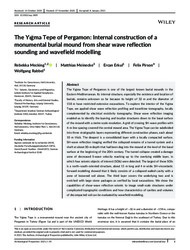The Yığma Tepe of Pergamon: Internal construction of a monumental burial mound from shear wave reflection sounding and wavefield modelling
Mecking, Rebekka; Meinecke, Matthias; Erkul, Ercan; Pirson, Felix; Rabbel, Wolfgang, 2021: The Yığma Tepe of Pergamon: Internal construction of a monumental burial mound from shear wave reflection sounding and wavefield modelling. In: Archaeological Prospection: n/a - n/a, DOI: 10.23689/fidgeo-4430.
 |
Dokument öffnen: |
The Yığma Tepe of Pergamon is one of the largest known burial mounds in the Eastern Mediterranean. Its internal structure, especially the existence and location of burials, remains unknown so far because its height of 32 m and the diameter of 158 m have restricted extensive excavations. To explore the interior of the Yığma Tepe, we applied shear wave reflection profiling and traveltime tomography, locally complemented by electrical resistivity tomography. Shear wave reflection imaging enabled us to identify the layering and localize structures down to the basal surface of the mound with a metre‐scale resolution. A grid of crossing SH‐wave profiles with 4‐m line spacing covered the central mound area. The Yığma Tepe can be subdivided into three stratigraphic layers representing different construction phases, each about 10 m thick. The deepest is a consolidated layer with a locally compacted surface. SH‐wave reflection imaging verified the collapsed remains of a tunnel system and a shaft at about 30‐m depth that had been dug into the mound at the level of the basal surface at the beginning of the 20th century. The tunnel collapse created a damage zone of decreased S‐wave velocity reaching up to the overlying middle layer, in which four seismic objects of interest (SOIs) were detected. The largest of these SOIs is a north–south‐oriented structure, about 15 m long and 4 m wide. SH‐viscoelastic forward modelling showed that it likely consists of a collapsed walled cavity with a zone of loosened soil above. The third layer covers the underlying two and is enriched with large stone packages as verified by local excavations. We show the capabilities of shear‐wave reflection seismic to image small‐scale structures under complicated topographic conditions and how characteristics of cavities and volumes of decompacted soil can be evaluated by wavefield modelling.
Statistik:
ZugriffsstatistikSammlung:
This is an open access article under the terms of the Creative Commons Attribution‐NonCommercial License, which permits use, distribution and reproduction in any medium, provided the original work is properly cited and is not used for commercial purposes.

